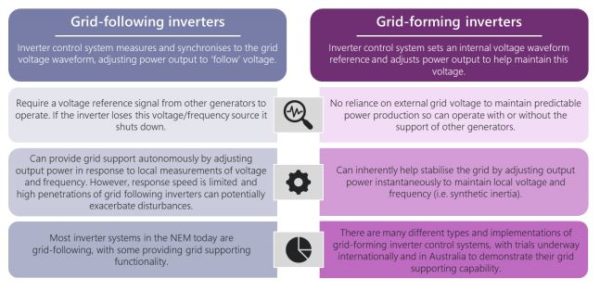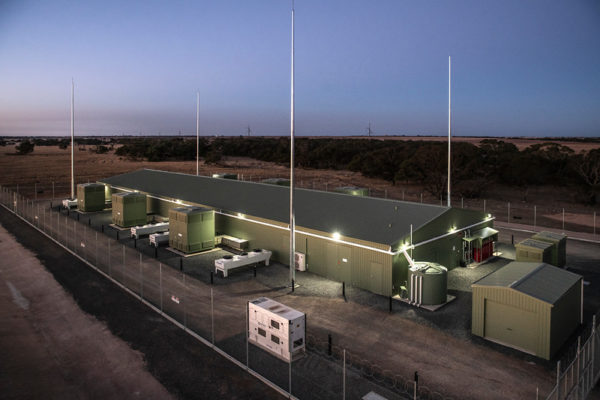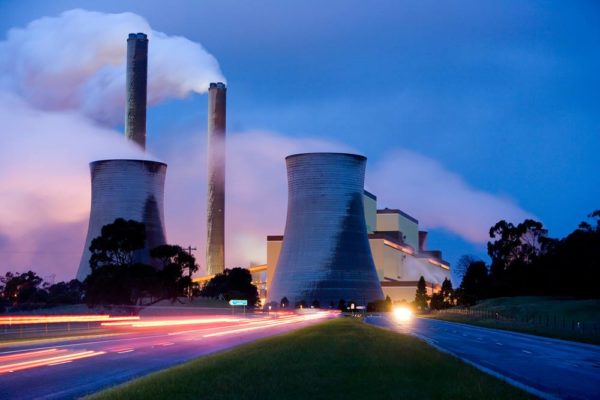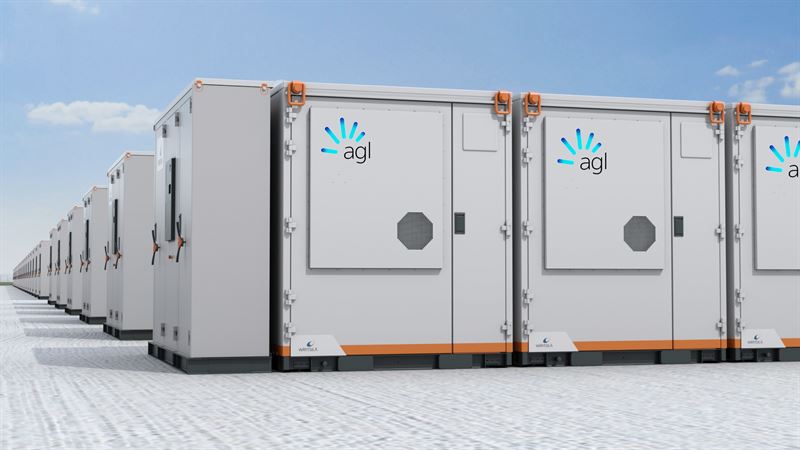The Torrens Island battery marks AGL’s first grid-scale storage project and will be built at the company’s gas plant, where it will continue to provide electricity as the fossil-fuel run turbines retire.
While the $180 million battery isn’t Australia largest and only has one hour of storage (it is expected to expand to four hours), the project will be the largest in the world with grid-forming capacity, and will undoubtedly be keenly observed within Australia and internationally.
Grid-forming vs. grid-following
The system, to be delivered by Wärtsilä, will operate initially in the usual grid-following mode, meaning the output synchronises to the grid’s voltage waveform. It will then be switched into the more novel grid-forming mode, making it capable of providing the grid with ‘virtual inertia.’

Image: AEMO
System strength services and inertia has traditionally been the realm of spinning mass fossil-fuel driven turbines but grid-forming projects hold promise as a clean substitute.
Their virtual inertia is provided by grid-forming inverters, which in this project will be provided by Germany company SMA. Also known as virtual synchronous generation, grid forming technology was flagged by the Australian Energy Market Operator (AEMO) just last week as a top priority because of the crucial role it expects the technology will play for the clean energy transition, which will see the country move from baseload generation, like coal plants, to variable renewable sources like solar, wind and batteries which rely on inverter-based technologies.
While large-scale demonstrations of grid-forming storage like Torrens Island are not yet in operation, Australia has already had some successes with the technology on a smaller scale – namely at the 30 MW/8 MWh Dalrymple Battery Energy Storage System, which is currently the only source of virtual inertia on the National Electricity Market. Storage systems with grid-forming inverters independently set their internal frequency and speed, making them able to form an islanded grid by generating a frequency reference. In other words, they can continue providing power to the network if the main grid goes down – something systems without that technology cannot do.

Image: ARENAWire
The news of the grid-forming plans for Torren Island comes hot off the heals of South Australia transmission provider ElectraNet deploying two synchronous condensers in the state, with another two in the woodwork. The primary role of these spinning machines is also to provide system strength and inertia, an example of old tech being redeployed for the new world. In comparison to grid-forming inverters, though, the solution appears far less flexible and unable to offer multiple services.
SMA said it will supply 109 Medium Voltage Power Stations (MVPS-SCS4200) to Wärtsilä for Torrens Island project. According to the company, its “MVPS-SCS4200” is a turnkey solution for large storage systems. With the new, robust battery central inverters Sunny Central Storage UP and coordinated medium-voltage components, the turnkey solution offers more power density, it added. The complex system is also supported by the GEMS Power Plant Controller and the energy management software from Wärtsilä.
“The Torrens Island project has huge implications globally; Australia is among the leading countries in the world when it comes to high levels of renewable energy feeding into the grid at particular times of the day,” Joshua Birmingham, Director of Large-Scale & Project Solutions at SMA Australia said.
AGL’s battery rollout
AGL, Australia’s biggest emitter, has committed to build 850 MW of battery-based assets by 2024 – a significant shift which will turn the colossal ship of AGL toward a new destination in the clean energy transition.
To that end, Torrens Island marks the first of those to be constructed at the site of a fossil-fuel power plant. It won’t be the last though, with big batteries planned for New South Wale’s Liddell and the Victoria’s Loy Yang coal plants.
In January, the company announced it had secured both Wärtsilä and Fluence under non-exclusive framework agreements to supply up to 1 GW of large-scale battery storage.

Image: AGL
This content is protected by copyright and may not be reused. If you want to cooperate with us and would like to reuse some of our content, please contact: editors@pv-magazine.com.









4 comments
By submitting this form you agree to pv magazine using your data for the purposes of publishing your comment.
Your personal data will only be disclosed or otherwise transmitted to third parties for the purposes of spam filtering or if this is necessary for technical maintenance of the website. Any other transfer to third parties will not take place unless this is justified on the basis of applicable data protection regulations or if pv magazine is legally obliged to do so.
You may revoke this consent at any time with effect for the future, in which case your personal data will be deleted immediately. Otherwise, your data will be deleted if pv magazine has processed your request or the purpose of data storage is fulfilled.
Further information on data privacy can be found in our Data Protection Policy.